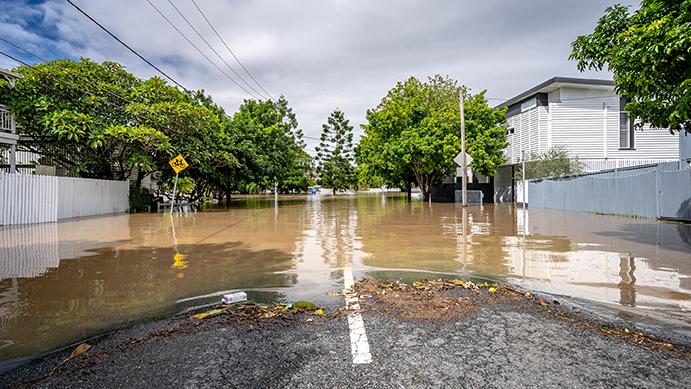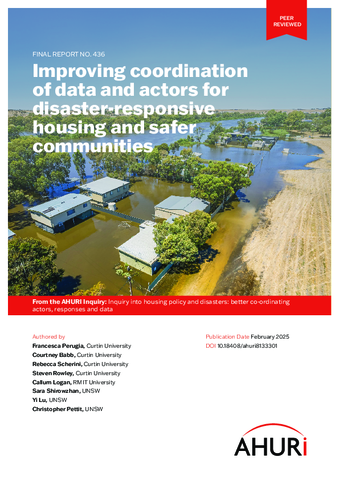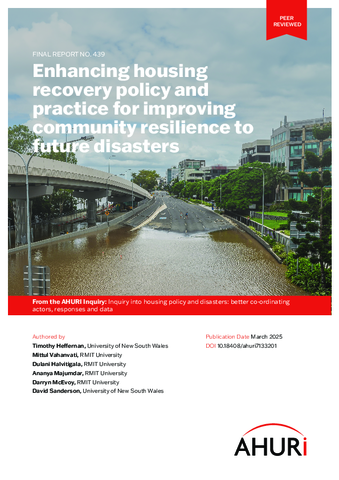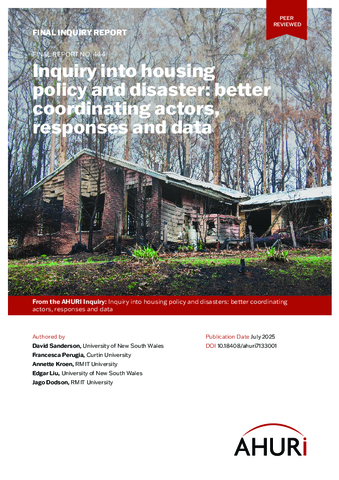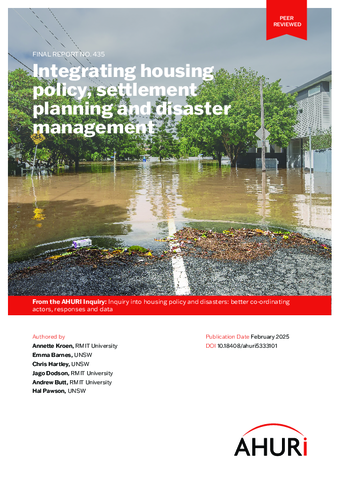From the AHURI Inquiry: Inquiry into housing policy and disasters: better coordinating actors, responses and data
What this research is about
This research looks at how housing policy and planning can better prepare for natural disasters, and enable recovery from them.
It examines institutional arrangements, planning coordination and disaster management responses.
Why this research is important
Australia faces many natural hazards like bushfires, floods, storms and cyclones. Climate change is making these events more frequent and intense. Because housing is heavily impacted during disasters, it's crucial that housing policy works closely with disaster risk reduction and response.
-
Key findings
Disaster damage to housing leads to disruptions such as homelessness or reliance on temporary shelter, plus the need to organise and finance rebuilding.
All levels of government have housing and disaster management responsibilities
Housing policy, settlement planning and disaster preparedness and response are not well coordinated across Australian governments.Government responsibilities for housing and disaster management are spread across three levels. States and territories lead housing and planning policy, while local councils often implement these plans. The Australian Government has expanded its role through national bodies like the National Emergency Management Agency.
Temporary housing supports households to return to normal
Temporary housing is critical for helping households return to normal. Support may be needed for months or years while permanent housing is rebuilt. The quality, cultural suitability and location of temporary housing are vital for successful recovery.Renters are more vulnerable to disaster impacts
Renters in the private market are more vulnerable to disaster impacts. They often have lower-quality housing, lower incomes and less insurance cover.It is often hard for renters to find temporary housing because they do not qualify for most support programs.
Data is needed for risk management
Data collection varies for different hazards. Bushfire mapping is mostly coordinated at state level, while flood risk assessment lacks a standard process and is often done by catchment authorities or local councils.Proper planning is crucial for reducing disaster risks
Land use decisions can limit development in risky areas, guide housing design and support emergency responses. However, balancing risk reduction with economic and social needs can be challenging.Managed retreat can reduce risk
Managed retreat refers to relocating households or whole settlements away from high-risk to lower risk areas. It is often politically controversial and rarely a preferred option due to the psychological impact on households.Managed retreat schemes could be supported by the insurance industry allowing people to rebuild in another ‘better’ area after a disaster.
Building to higher standards to cope with disasters can lead to higher costs, and lower take up
Increased building standards to reduce the impact of natural hazards often adds to the cost of a building. This can create resistance to new building standards. -
Policy actions
The research found two key areas need to be addressed:
- There needs to be improved integration between housing policy, planning and disaster management across all levels of government and between government and emergency and disaster agencies.
- There is a need to raise disaster risk awareness in housing and planning agencies, with risk reduction prioritised and integrated more clearly into planning policy.
Policy developments could include:
- limiting urban expansion into risk areas
- clarifying urban development rules
- evaluating temporary housing programs
- delivering worker accommodation following a disaster
- supporting private renters to recover by accessing temporary housing and other assistance after disasters
- creating incentives for home owners to build or retrofit above the required standard
- developing hazard-oriented planning policies
- establishing a risk assessment database
- improving coordination within and between agencies
- clarifying government responsibilities
- including communities in disaster planning
- enhancing insurance policies for safer rebuilding.
-
Research design
This research reviewed academic and grey literature on housing policy, planning and disaster prevention, preparedness and response. It focused on Australian and state government arrangements, with case studies in Victoria, New South Wales, and Western Australia. Research involved document analysis and stakeholder interviews.
This research is part of a wider AHURI Inquiry Housing policy and disasters: better co-ordinating actors, responses and data.

